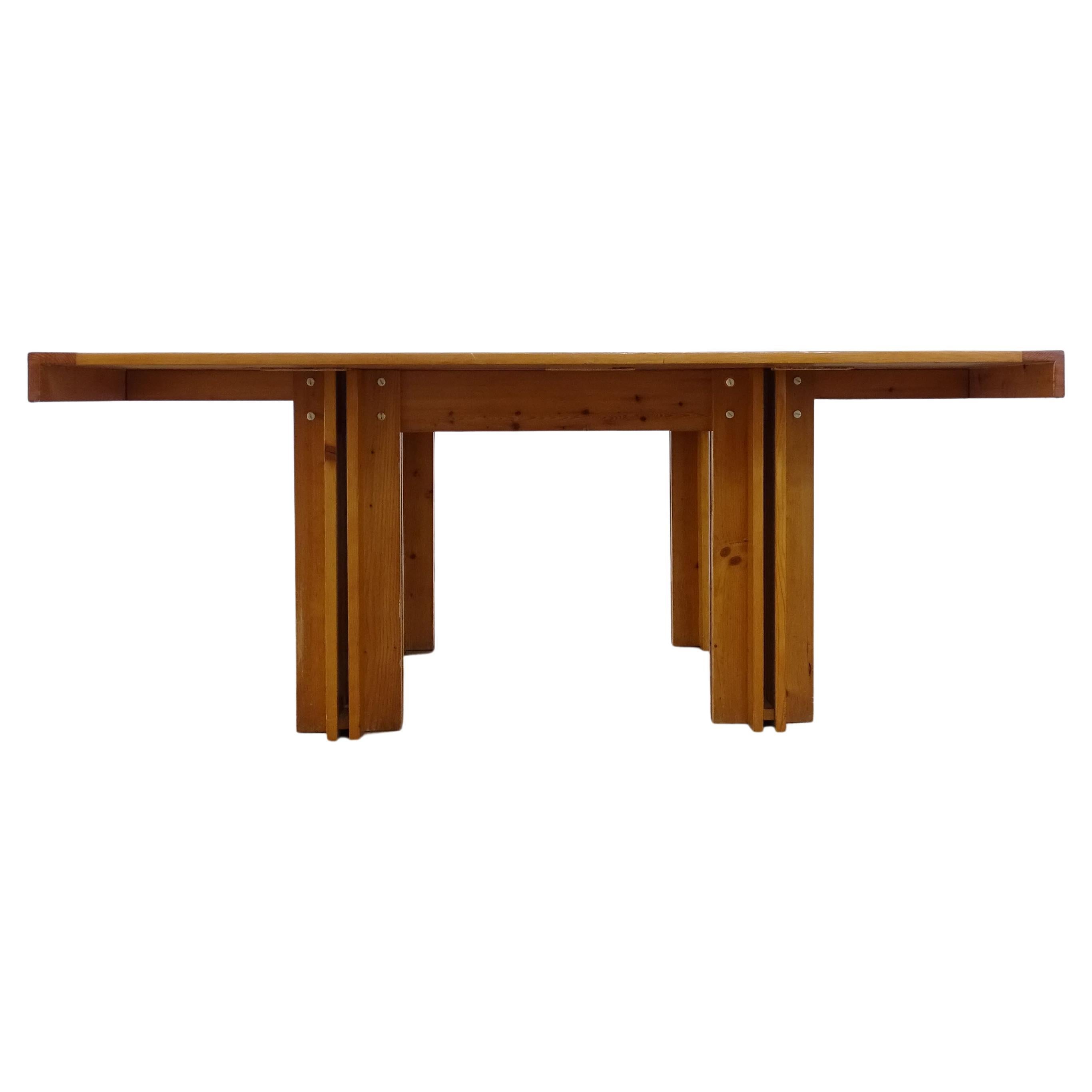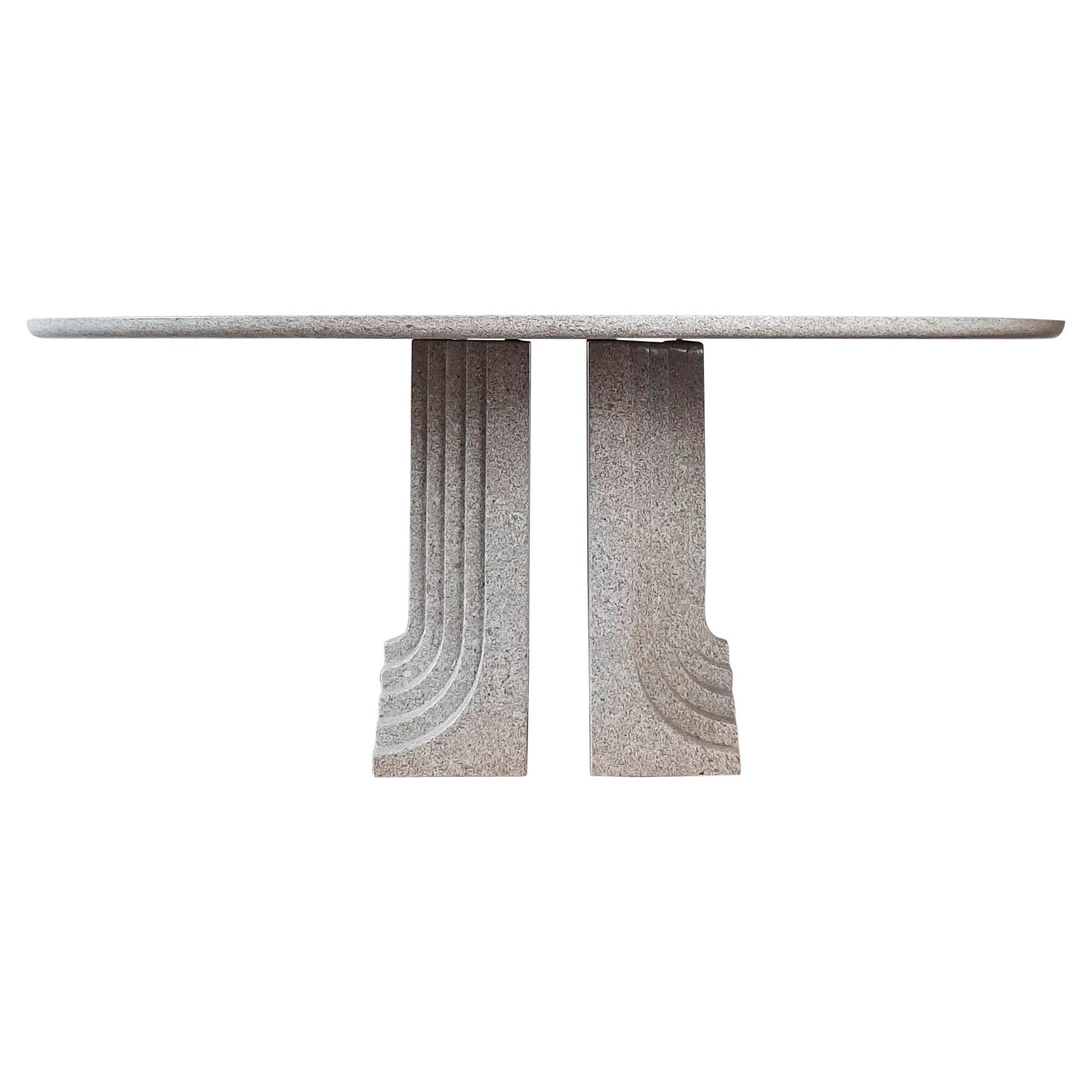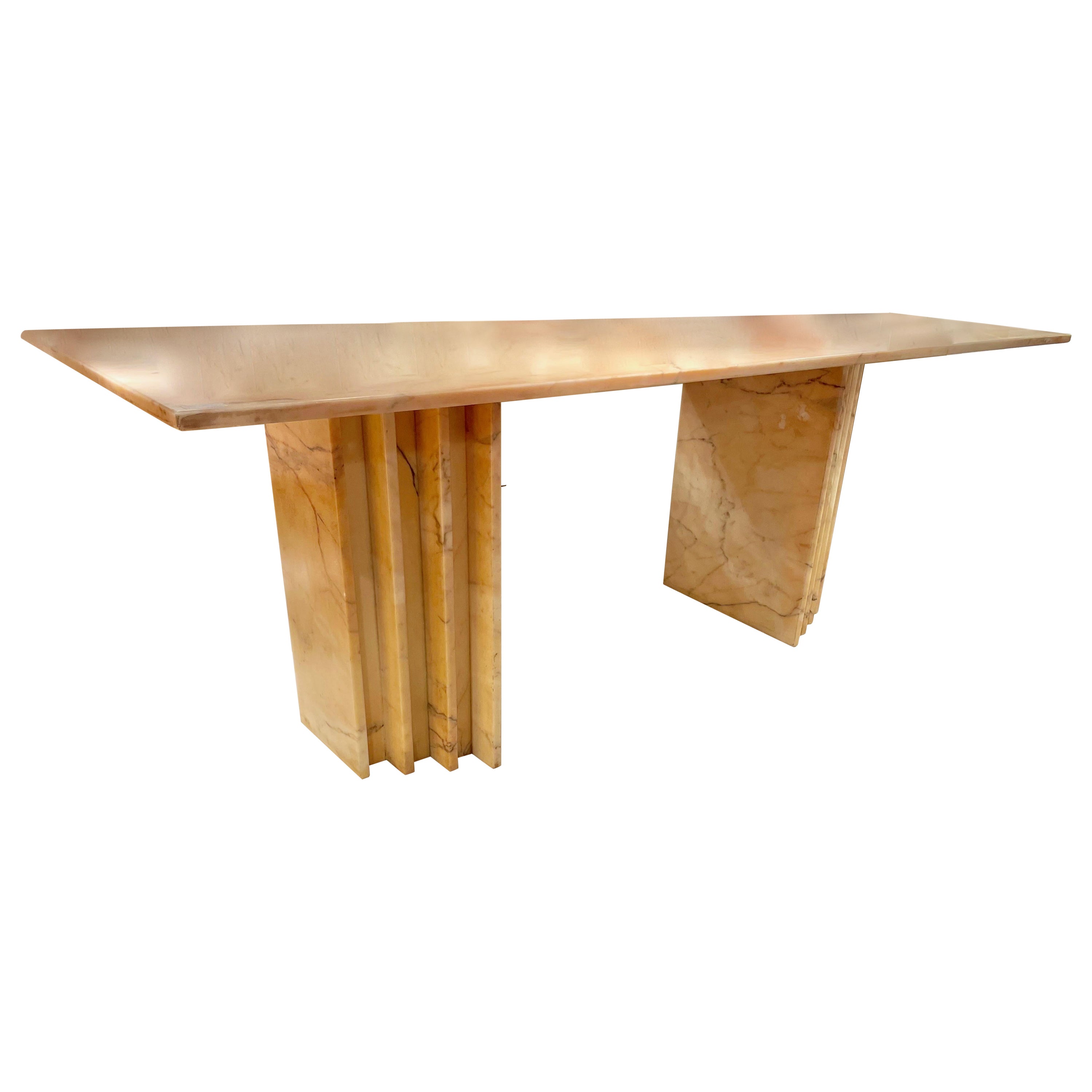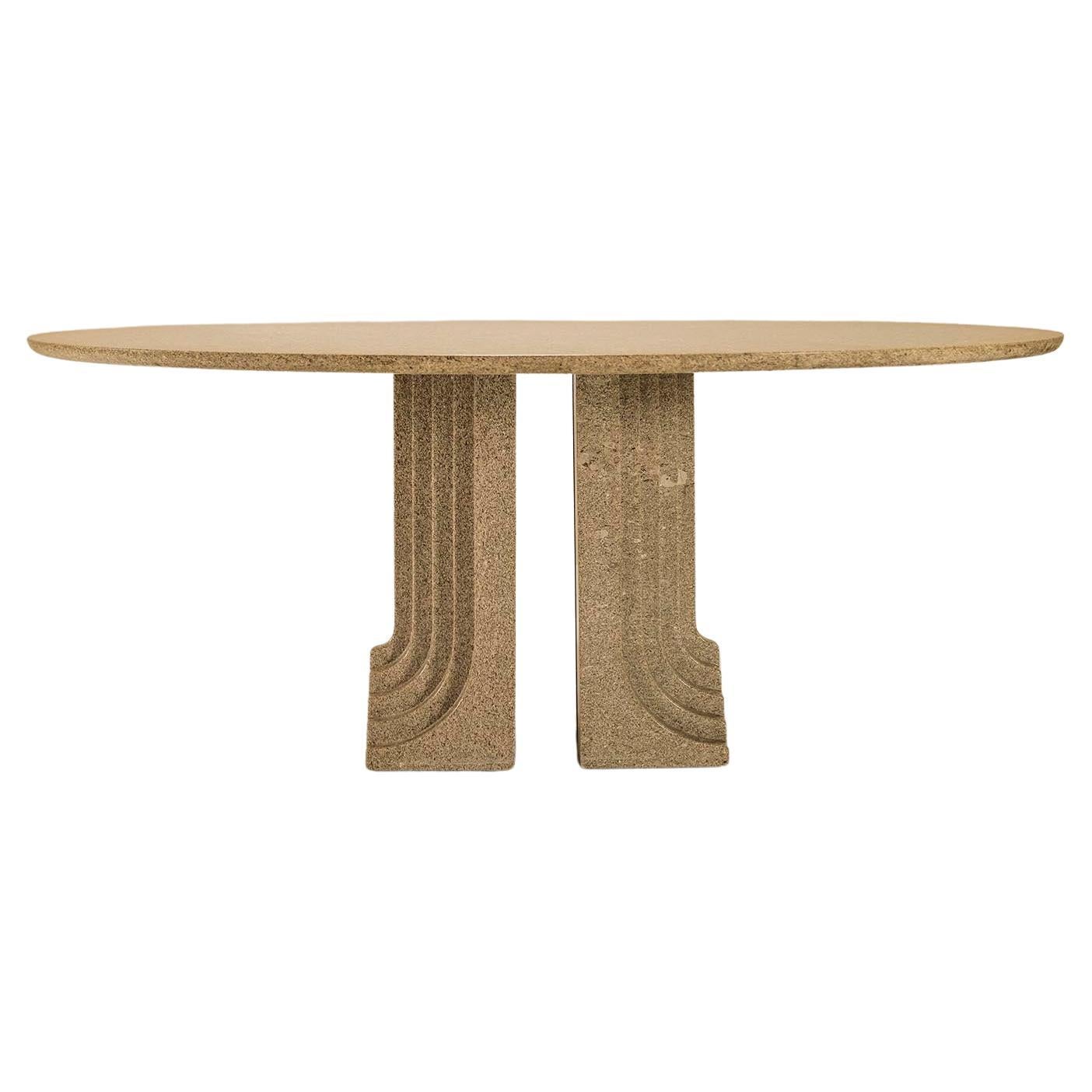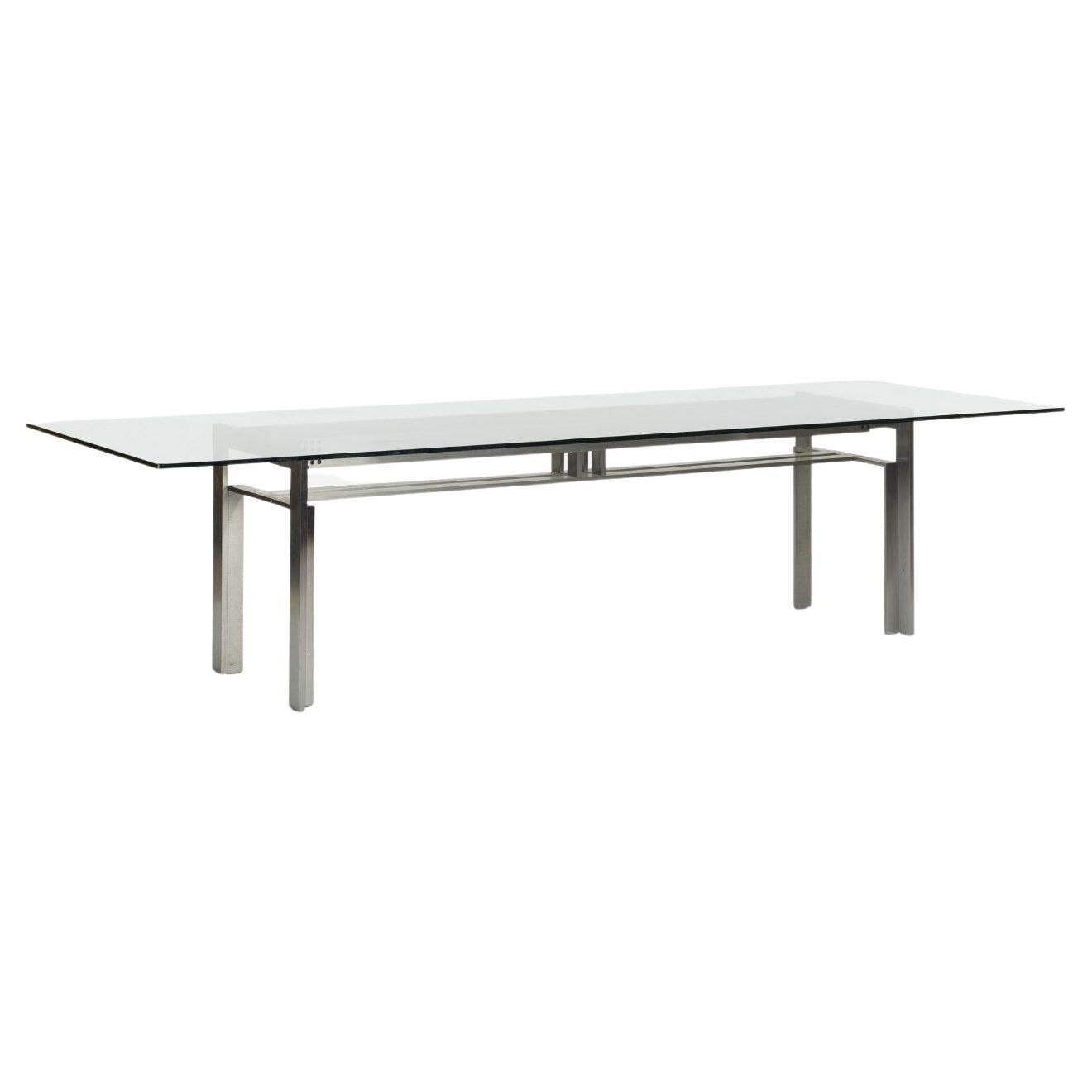Items Similar to Carlo Scarpa, Small Dining Table Model “Quatour”, Walnut, Italy 1974
Want more images or videos?
Request additional images or videos from the seller
1 of 8
Carlo Scarpa, Small Dining Table Model “Quatour”, Walnut, Italy 1974
About the Item
Carlo Scarpa
Dining table model “Quatour”
Manufactured by Simon Gavina
Italy, 1974
Walnut wood
Measurements:
141 cm x 141 cm x 72 H cm
55.9 in x 55.9 in x 28 H in.
Literature:
Giuliana Gramigna, Repertorio 1950/1980, Milan, 1985, p. 327; Virgilio Vercelloni, The Adventure of Design: Gavina, Milan, 1987, pp. 74-75
Concept:
This model Riomarin table was designed by Carlo Scarpa in 1947 for the Metamobile project. It put into production by Simon/Gavina in 1974, who intended to defend themselves against accusations that they produced furniture only for the rich bourgeoisie. Metamobile was a line of simple furniture at a low price, encapsulating the idea that every person could be enabled to make furniture on their own. This piece is made from simple solid fir slats.
Biography:
Born in Venice in 1906, Carlo Scarpa studied architectural design at the Royal Academy of Fine Arts in Venice. After graduating in 1926, he taught architectural drawing at the Academy, where he held multiple posts throughout his life. At the same time, Scarpa launched his career as an industrial and interior designer, creating multiple designs for Venini Glass Works in Venice. His most recognized pre-war project, however, was the 1935 restoration and renovation of the School of Economics at the University of Venice. His Postwar commissions consisted primarily of historic building renovations, interior remodeling, and exhibition installations, often revealing the influence of Art Nouveau, Frank Lloyd Wright, and Josef Hoffmann.
Scarpa’s architecture is characterized by a great sensitivity to the changes of time. Important projects include the Canova Plaster Cast Gallery in Possagno (Treviso) (1955-1957); Olivetti showroom in Piazza S. Marco, Venice (1957-1958); and the Banca Popolare di Verona, which Scarpa began in 1973, and which was completed after his death by Arrigo Rudi.
He created multiple landscape, garden, and building designs across Italy, as well as in Canada, the U.S., Saudi Arabia, Switzerland, and France. He died in Japan in 1978. He is buried, fittingly, in the Brion Tomb complex in the San Vito d’Altivole (Treviso) cemetery, a 1969 Scarpa design that some call his most important work.
- Creator:Carlo Scarpa (Designer)
- Dimensions:Height: 28.35 in (72 cm)Width: 55.52 in (141 cm)Depth: 55.52 in (141 cm)
- Materials and Techniques:
- Place of Origin:
- Period:
- Date of Manufacture:1974
- Condition:
- Seller Location:Barcelona, ES
- Reference Number:1stDibs: LU2374319281112
About the Seller
5.0
Vetted Seller
These experienced sellers undergo a comprehensive evaluation by our team of in-house experts.
Established in 2015
1stDibs seller since 2016
92 sales on 1stDibs
Typical response time: 5 hours
- ShippingRetrieving quote...Ships From: Barcelona, Spain
- Return PolicyA return for this item may be initiated within 2 days of delivery.
More From This SellerView All
- Franco Albini Mahogany mid-centry Italian Table Model TL-22 produced by PoggiBy Franco AlbiniLocated in Barcelona, ESFranco Albini & Franca Helg. Dining table model no. TL22. Manufactured by Poggi, Italy, 1958. Mahogany. Measurements: 180.3 cm x 104.1 cm x 73 H cm. 70.98 in x 40.98 in x 28.74 in. Literature: Giuliana Gramigna, Repertorio 1950/1980, Milan, 1985, p. 123. Franco Albini, was born in 1905 and died in 1977. He spent his childhood and part of his youth in Robbiate in Brianza, where he was born. Albini, as an adolescent moved with his family to Milan. Here he enrolled in the Faculty of Architecture of the Polytechnic and graduated in 1929. He started his professional activity in the studio of Gio Ponti and Emilio Lancia, with whom he collaborated for three years. At the 1929 International Exhibition in Barcelona (where Gio Ponti curated the Italian pavilion and Mies van der Rohe realized that of Germany) and in Paris where, as Franca Helg recounted, he had the opportunity to visit the studio by Le Corbusier. In those three years, the works he carried out are admittedly of the twentieth century imprint. It is the meeting with Edoardo Persico that marked a clear turning point towards rationalism and the approach to the group of editors of "Casabella". The partly ironic and partly very harsh comments of the Neapolitan critic to a series of drawings, made by Albini for the design of some office furniture, caused him a great disturbance. “I spent days of real anguish - Albini recalls - I had to answer all the questions. I also had a fever, a large and long fever. " The meted provoked Albini to openen a professional studio in via Panizza with Renato Camus and Giancarlo Palanti. The group of architects began to deal with public housing by participating in the competition for the Baracca district in San Siro in 1932 and then building the IFACP neighborhoods: Fabio Filzi (1936/38), Gabriele D'Annunzio and Ettore Ponti (1939). During this period, Albini also worked on his first villa (Pestarini), which Giuseppe Pagano, architect and critic of the time, presented as follows: “This coherence, which the superficial rhetoric of fashionable jugglers calls intransigence, and which is instead the basis of understood between the fantasy of art and the reality of the craft, in Franco Albini, it is so rooted that it transforms theory into a moral attitude ". But it is above all in the context of the exhibitions that the Milanese master experienced his compromise between that "rigor and poetic fantasy" of which Pagano speaks, coining the elements that became a recurring theme in his . The opening in 1933 of the new Triennale headquarters in Milan, in the Palazzo dell'Arte, was an important opportunity to express the strong innovative character of rationalist thinking, a gym in which to freely experiment with new materials and new solutions, but above all a "method". "Cultivated as a communication laboratory, the art of setting up was for the rationalists of the first generation what the perspective had been for the architects of humanism: the field open to a hypothesis of space that needed profound reflections before landing the concreteness of the construction site ". Together with Giancarlo Palanti, Albini on the occasion of the V Triennale di Milano set up the steel structure house (with R. Camus, G. Mazzoleni, G. Minoletti and with the coordination of G. Pagano), for which he also designed the 'furniture. At the following Triennale of 1936, Persico dided, together with a group of young designers gathered by Pagano in the previous edition of 1933, Franco Albini took care of the preparations of the home exhibition. The setting up of Stanza per un uomo, at that same Triennale, allows us to understand the acute and ironic approach of Albini, as a man and as a designer: "Celebrating the beauty of mechanics was the imperative to which, for example, the surprising displays by Franco Albini who managed, in the subtle way of a refined and rarefied style, to sublimate their practical content in the metaphysics of daring still lifes: flying objects which marked in the void refined frames and metal intricacies the nodes of a fantastic cartography where industry finally became art free from purpose ". That same year Albini and Romano designed the exhibition of the Ancient Italian Goldsmithery: vertical uprights, simple linear rods, designed the space. A theme, of the "flagpole", seemed to be the center of the evolution of production and the creative process. The concept is reworked over time, with the technique of decomposition and recomposition typical of Albinian design: in the preparation of the Scipione Exhibition and contemporary drawings (1941) the tapered flagpoles, on which the paintings and display cases were hung, are supported by a grid of steel cables; in the Vanzetti stand (1942) they take the V-shape; in the Olivetti shop in Paris (1956) the polished mahogany uprights support the shelves for the display of typewriters and calculators. The flagpole is found, however, also in other areas. In the apartments he designed, it is used as a pivot on which the paintings can be suspended and rotated to allow different points of view, but at the same time as an element capable of dividing the spaces. The Veliero bookcase...Category
Mid-20th Century Italian Mid-Century Modern Dining Room Tables
MaterialsMahogany
- Dining table by Joaquim Tenreiro, 1950By Joaquim TenreiroLocated in Barcelona, ESImportant dining table Manufactured by Tenreiro Moveis e Decoraçoes Brazil, 1950 Solid jacaranda ebonized wood and white lacquered formica top Measurements 223 cm x 98 cm x 74h cm 8...Category
Vintage 1950s Brazilian Dining Room Tables
MaterialsFormica, Jacaranda
- Sam Chermayeff Contemporary Galvanized Steel Large Dining Table "Beasts" SeriesBy Sam ChermayeffLocated in Barcelona, ESSam Chermayeff Dining table From the series “Beasts” Produced in exclusive for SIDE GALLERY Manufactured by ERTL und ZULL Berlin, 2021 Galvanized steel, high polished steel Co...Category
21st Century and Contemporary German Dining Room Tables
MaterialsSteel, Stainless Steel
- Contemporary Dark Grey Marble Dining Table "Concept Kitchen" by Sam ChermayeffBy Sam ChermayeffLocated in Barcelona, ESSam Chermayeff Table From the series “Concept Kitchen” Produced in exclusive for SIDE GALLERY Manufactured by Bagnara Italy, 2020 Pannonia Grün marble Contemporary Design M...Category
21st Century and Contemporary German Dining Room Tables
MaterialsMarble
- Lukas Saint-Joigny, Contemporary Round Dining Table, 2020, Light Grey ResinBy Lukas Saint-JoigyLocated in Barcelona, ESLukas Saint-Joigny Round Dining Table From the “Ore” series Manufactured by Lukas Saint-Joigny Produced in exclusive for SIDE GALLERY Paris, 2020 Various materials and polyuret...Category
21st Century and Contemporary French Dining Room Tables
MaterialsResin
- Sergio Rodrigues Round Wooden Dining Table "Stella" Oca mid-century Brazil 1956By Oca, Sergio RodriguesLocated in Barcelona, ESSergio Rodrigues (1927-2014) Round dining table model “Stella” Manufactured by Oca Brazil, 1956 Jacaranda wood, brass, iron Measurements 122 cm diameter x 73 height cm 48 in diamet...Category
Mid-20th Century Brazilian Mid-Century Modern Dining Room Tables
MaterialsBrass, Iron
You May Also Like
- Early Carlo Scarpa Quatour Table for Simon Gavina, Italy, 1974By Carlo Scarpa, Simon Gavina EditionsLocated in Milan, ITEarly and Large version Carlo Scarpa Quatour table for the Metamobile series by Simon Gavina, Italy 1974.Category
Vintage 1970s Italian Mid-Century Modern Tables
MaterialsWood, Pine
- Quatour Wooden Table by Carlo Scarpa for Gavina, Italy 1973By Tobia Scarpa, Carlo ScarpaLocated in Argelato, BOLarge Quatour table with wooden structure and veneered wooden top. Original drawing by Carlo Scarpa. Prod. Gavina, Italy, 1974 cm 165x165x72 Further information Bibliography (edite...Category
Vintage 1970s Italian Minimalist Dining Room Tables
MaterialsWood
- 1970s Italian Oval Dining Table by Carlo Scarpa, Model Samo, in Grey GraniteBy Carlo ScarpaLocated in Baambrugge, NLVintage oval dining table designed model Samo, by Carlo Scarpa and Manufactured by Simon, Italy 1970s. Light grey granite dining table with o...Category
Vintage 1970s Italian Dining Room Tables
MaterialsGranite
- Dining Room Marble Table Attributed to Carlo Scarpa, Italy 1970.By Carlo ScarpaLocated in Brussels, BESpectacular pink beige marble dining table in three parts. The top is resting on a stepped base. Attributed to Scarpa, Italy 1970.Category
Vintage 1970s Italian Mid-Century Modern Dining Room Tables
MaterialsMarble
- Carlo Scarpa 'Samo' Dining Table for Simon Gavina, Italy, 1970sBy Carlo Scarpa, Simon Gavina EditionsLocated in Hellouw, NLThis Italian dining table from the 1970s exudes timeless elegance and beauty. It was designed by perhaps one of the prominent Italian modernist designers of the last century. What im...Category
Vintage 1970s Italian Mid-Century Modern Dining Room Tables
MaterialsGranite
- Carlo Scarpa for Cassina - Doge Dining TableBy Cassina, Carlo ScarpaLocated in Zagreb, HRDoge table in glass and steel, designed in 1968 by one of the most influential Italian architects and designers Carlo Scarpa for the great Italian visionary Dino Gavina and his compa...Category
Vintage 1970s Italian Mid-Century Modern Dining Room Tables
MaterialsSteel, Brass
Recently Viewed
View AllMore Ways To Browse
Small Italian Tables
Used Industrial Dining Table
Walnut Small Table
Small French Dining Table
Fine French Dining Table
Small Fining Table
Great Room Ideas
Low Dining Table
Industrial Small Table
Dining Table French Italian
French Industrial Dining Table
Walnut Dining Table Small
Used School Dining Tables
Small Wood French Dining Table
Italian Table Scarpa
Small Industrial Dining Table
French Work Table Walnut
Small Japanese Table
